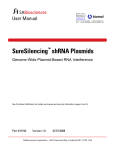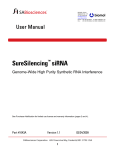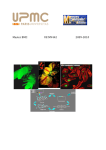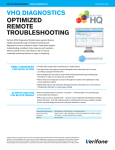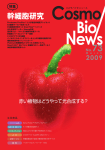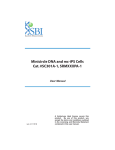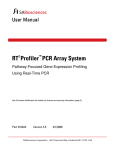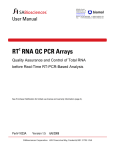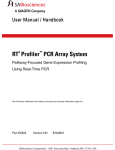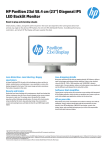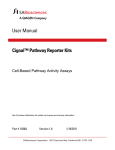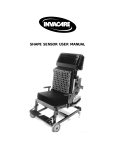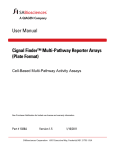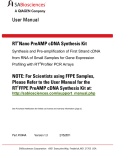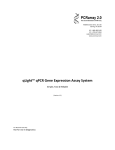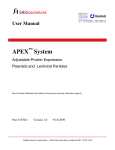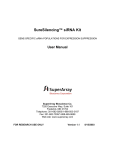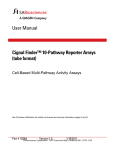Download User Manual - SABiosciences
Transcript
User Manual ™ SureSilencing shRNA Plasmids Genome-Wide Plasmid-Based RNA Interference See Purchaser Notification for limited use license and warranty information (pages 2 and 3). Part #1019A Version 1.8 07/01/2008 ™ SureSilencing shRNA Plasmids Genome-Wide Plasmid-Based RNA Interference User Manual (For Catalog Numbers KX#####G/H/N/P) Ordering and Technical Service Contact Information: • • • • Tel: Fax: On-line Order: E-MAIL: 1-888-503-3187 (US) 301-682-9200 (outside US) 1-888-465-9859 (US) 301-682-7300 (outside US) www.SABiosciences.com [email protected] (to place an order) [email protected] (for technical support) You may place orders by fax, e-mail or from our website. Each order should include the following information: • • • • • Your contact information (name, phone, email address) Product name, catalog number and quantity Purchase order number or credit card information (Visa or MasterCard) Shipping address Billing address For more information, visit us at www.SABiosciences.com NOTICE TO PURCHASER I This product is made under license from The Carnegie Institution of Washington. However, the purchase of this material by a nonacademic or for-profit organization will require a license to use the material from Carnegie. License queries may be directed to Gloria Brienza or Gary Kowalczyk at The Carnegie Institution of Washington, 1530 P Street NW, Washington, DC 20005. LIMITED PRODUCT WARRANTY This product is intended for research purposes only and is not intended for drug or diagnostic purposes or for human use. This warranty limits our liability to replace this product in the event the product fails to perform due to any manufacturing defect. SABiosciences Corporation makes no other warranties of any kind, expressed or implied, including without limitation, warranties of merchantability or fitness for a particular purpose. SABiosciences Corporation shall not be liable for any direct, indirect, consequential or incidental damages arising out of the use, the results of use or the inability to use this product. NOTICE TO PURCHASER II The purchase of SureSilencing™ shRNA Plasmids includes a limited, nonexclusive license to use the kit components for research use only. This license does not grant rights to use the kit components for reproduction of any shRNA, to modify kit components for resale or to use SureSilencing™ shRNA Plasmids to manufacture commercial products without written approval of SABiosciences Corporation. No other license, expressed, implied or by estoppel, is granted. U.S. patents may cover certain isolated DNA sequences included in the SureSilencing™ shRNA Plasmids. Presently, it is not clear under U.S. laws whether commercial users must obtain licenses from the owners of the rights to these U.S. patents before using SureSilencing™ shRNA Plasmids. SABiosciences Corporation 6951 Executive Way, Suite 100; Frederick, MD 21703; USA 2 CONTENTS I. Background and Introduction 4 II. Kit Contents and Vector Information 6 III. Additional Materials Required 7 IV. Protocol 9 A. Transfection 9 B. Selection or Enrichment 11 C. Assay Effects of Silencing Gene Expression 14 V. SureSilencing shRNA Plasmid FAQ 15 VI. Troubleshooting Guide 17 Appendix A: Neomycin Parent Vector Sequence Information 21 Appendix B: GFP Parent Vector Sequence Information 22 Appendix C: Puromycin Parent Vector Sequence Information 23 Appendix D: Hygromycin Parent Vector Sequence Information 24 Appendix E: Plasmid Preparation and Quality Control 25 Appendix F: Real-time RT-PCR Protocol for Verifying Suppression 27 Technical Support: [email protected] 3 www.SABiosciences.com ™ SureSilencing shRNA Plasmids I. Background and Introduction RNA Interference, a now commonplace and popular method for exploring gene function, suppresses the expression of a specific gene of interest in transformed mammalian cell culture. Upon suppression, missing or altered activities in the cell can be attributed to the function of the affected gene. However, the most commonly used technique, small interfering RNA (siRNA), proves useful for some applications but not all. This technique works optimally with cells known to be easily and readily transfected with nucleic acid, but not in cells with low transfection efficiencies. Small interfering RNA does not allow transfected cells to be identified, preventing both enrichment and determination of transfection efficiency. Additionally, due to a lack of selection markers, siRNA only works under transient and not stable transfection conditions, preventing the exploration of longterm gene-suppression effects. The SureSilencing shRNA plasmids are designed using an experimentally validated algorithm. These constructs specifically knock down the expression of specific genes by RNA interference and allow for enrichment or selection of transfected cells. Each vector expresses a short hairpin RNA, or shRNA, under control of the U1 promoter and either the hygromycin, neomycin, or puromycin resistance gene, or the GFP gene. Hygromycin, neomycin or puromycin resistance permits selection of stably transfected cells. GFP helps estimate transfection efficiencies, tracks transfected cells by fluorescence microscopy, and permits FACS-based enrichment of transiently transfected cells. The ability to select or track and enrich shRNA-expressing cells brings RNA interference to cell lines with lower transfection efficiencies. Unlike siRNA, plasmid-based shRNA also provide a renewable source of RNA interference reagent. Our experimentally verified shRNA design algorithm assures gene-specificity and efficacy. An advanced specificity search in addition to BLAST built into the algorithm helps to reduce the potential off-target effects. At least two of the provided SureSilencing shRNA Plasmids is guaranteed to knock down expression of the targeted gene at the RNA level by at least 70 percent in transfected cells upon selection for antibiotic resistance or FACSbased enrichment for GFP expression. ™ Benefits of the SureSilencing shRNA Plasmids: • Enrich or Select: Plasmids are available with either GFP Marker, Hygromycin, Neomycin, or Puromycin Resistance enabling either enrichment and short-term studies or selection and the study of the long-term effects of gene suppression. • GUARANTEED!*: Knock down expression of any targeted human, mouse, or rat gene by at least 70 percent. Control for non-specific and off-target effects. • Convenient & Cost-Effective: Use standard transfection methods. Plasmids provide a renewable source of RNA Interference. * At least two of the four provided pre-designed SureSilencing™ shRNA Plasmids are guaranteed to knock down expression of the targeted gene at the RNA level by at least 70 percent as measured by real-time qRTPCR in transfected cells upon FACS-based enrichment for GFP expression or selection for neomycin or puromycin resistance as described in this User Manual. Technical Support: [email protected] 4 www.SABiosciences.com Version 1.8 ™ Figure 1: Overview of SureSilencing shRNA Plasmid Procedure. Technical Support: 888.503.3187 (US) 5 301.682.9200 ™ SureSilencing shRNA Plasmids II. Kit Contents and Vector Information A. Kit Contents: Component shRNA NC Specification SureSilencing™ shRNA vector Negative Control shRNA* vector Quantity Four (4) One (1) * The negative control shRNA is a scrambled artificial sequence which does not match any human, mouse, or rat gene. NOTE: These plasmids are transformation-grade ONLY and are prepared and meant for introduction and amplification in bacteria FIRST. These plasmids ARE NOT transfectiongrade and ARE NOT provided in a large amount or of high enough quality for direct introduction into a mammalian cell line of interest. Storage Conditions: All components included with this catalog number are shipped with cold ice packs. The plasmids must be stored at -20 °C and are guaranteed for 6 months from the date received. B. Vector Information: Plasmids contain either one of three markers identifiable by the catalog number scheme: 1. Plasmids with catalog numbers ending in the letter “H” contain the hygromycin resistance gene for selection of stably transfected cells. 2. Plasmids with catalog numbers ending in the letter “N” contain the neomycin resistance gene for selection of stably transfected cells. 3. Plasmids with catalog numbers ending in the letter “P” contain the puromycin resistance gene for selection of stably transfected cells. 4. Plasmids with catalog numbers ending in the letter “G” contain a gene encoding a Green Fluorescent Protein (GFP) for fluorescence microscopy-based tracking or FACS-based enrichment of transiently transfected cells. The shRNA sequences and the negative control sequence are provided with each product information sheet included with the plasmid set. The sequences were cloned downstream of the U1 promoter of the plasmid. For detailed information about the parent vectors including vector maps and sequences, see Appendixes A, B, C, and D. Technical Support: [email protected] 6 www.SABiosciences.com Version 1.8 III. Additional Materials Required: A. For Transformation and Plasmid Purification: 1. Competent E. coli cells: In general, any strain designed for the amplification of plasmid may be used. We recommend JM109 competent cells (Promega Cat. No. L1001 or 2001). 2. Ampicillin: Molecular Biology grade from any source. 3. LB medium and agar (Gibco) Recipe for LB-ampicillin agar plates: Add 15 g agar to 1 liter of LB medium. Autoclave. Allow the medium to cool to 50 °C before adding ampicillin (50 μg/ml, final concentration). Pour 30-35 ml of medium into 85 mm Petri dishes. Let the agar solidify. Store at 4 °C for up to 1 month or at room temperature for up to 1 week. 4. Plasmid Purification Kit, such as: a. EndoFree Plasmid Maxi Kit Qiagen Cat. No. 12362 For purification of up to 500 μg transfection-grade plasmid DNA OR b. QIAfilter Plasmid Midi Kit Qiagen Cat. No. 12243 For fast purification of up to 100 μg transfection-grade plasmid DNA PLUS EndoFree Plasmid Buffer Set Qiagen Cat. No. 19048 Endotoxin-free buffer set for 10 mega- or 5 giga- transfection grade plasmid DNA preps NOTES: • Because plasmid DNA purity and quality are crucial for optimal transfection efficiencies and therefore the success of the shRNA-based gene suppression, we do not recommend using mini-preparations of plasmid DNA for transfection. • For guidance on carrying out transformations and plasmid preps, and performing quality control testing on plasmid preps prior to transfection, refer to Appendix E. B. For Transfection: 1. We recommend using SureFECT™ Transfection Reagent (SABiosciences Cat. No. SA-01). 2. Antibiotic (Molecular Biology and/or Tissue Culture Grade): Hygromycin, G418 (for use with the Neomycin-resistance plasmids), or Puromycin. Technical Support: 888.503.3187 (US) 7 301.682.9200 ™ SureSilencing shRNA Plasmids C. For Real-Time RT-PCR Verification of Gene Suppression: 1. RT2 PCR Array First Strand Kit Catalog Number C-02 2. SABiosciences RT2 Real-Time™ SYBR Green PCR Master Mix Be sure to pick the correct one for the instrumentation in your laboratory. RT2 Real-Time™ SYBR Green / ROX: Specifically designed for: All ABI and Stratagene Instrumentation Eppendorf Mastercycler® ep realplex Instruments with ROX filter set Catalog Number Size PA-012 For 2 RT2Profiler™ PCR Arrays PA-012-12 For 12 RT2Profiler™ PCR Arrays PA-012-24 For 24 RT2Profiler™ PCR Arrays RT2 Real-Time™ SYBR Green / Fluorescein: Specifically designed for BioRad iCylcer®, MyiQ®, and iQ5 Instrumentation Catalog Number Size PA-011 For 2 RT2Profiler™ PCR Arrays PA-011-12 For 12 RT2Profiler™ PCR Arrays PA-011-24 For 24 RT2Profiler™ PCR Arrays RT2 Real-Time™ SYBR Green: Specifically designed for instrumentation that does not require a reference dye: BioRad (MJ Research) Opticon, Opticon 2, and Chromo 4 Roche LightCycler® 480 System Eppendorf Mastercycler® ep realplex Instruments without ROX filter set Catalog Number Size PA-010 For 2 RT2Profiler™ PCR Arrays PA-010-12 For 12 RT2Profiler™ PCR Arrays PA-010-24 For 24 RT2Profiler™ PCR Arrays 3. RT2 PCR Primer Set targeting the suppressed target gene of interest and a housekeeping gene, such as ACTB of GAPD, to normalize the real-time PCR results Technical Support: [email protected] 8 www.SABiosciences.com Version 1.8 IV. Protocol: A. Transfection: NOTES: o Plasmid DNA purity and quality are crucial for optimal transfection efficiencies, and therefore the success of shRNA-based gene suppression. o For guidance on carrying out transformations and plasmid preps, and performing quality control testing on plasmid preps prior to transfection, refer to Appendix E. We recommend the use of SureFECT transfection reagent (SABiosciences cat. no. SA-01). For virtually all cell lines tested, SureFECT is an exceptional transfection reagent, providing maximal transfection efficiency and minimal toxicity. If you have already optimized a transfection reagent and protocol for your cell line of interest, you may use that protocol to transfect the SureSilencing shRNA Plasmids into the same cell line. Just be sure that the original protocol optimization used plasmids and determined % transfected cells (rather than relying on relative reporter activities). We recommend using reverse transfection protocols with the SureFECT transfection reagent. This is due to the time savings and improved reproducibility of using this method, compared to traditional forward transfection methods. SureFECT will also work well as a reagent for traditional forward transfection methods. The following protocols are written on a per well basis, and are designed for the transfection of an adherent cell line, 293H (Invitrogen), with the SureFECT transfection reagent, using a 24-well cell culture plate. We recommend that you set up three (3) replicate transfections for each of the four gene-specific and the negative control SureSilencing shRNA Plasmids using an optimized transfection protocol. Reverse Transfection Protocol This is just a general guideline; the optimal conditions/amounts should be determined for each new cell line/cell type being transfected. a. Dispense 100 µl of Opti-MEM™ I Reduced-Serum Medium (Gibco) into the appropriate well of a 24-well cell culture plate. b. Dispense 0.40 µg of the appropriate gene-specific shRNA plasmid or the negative control shRNA plasmid into the Opti-MEM™. Mix by gently rocking the plate back and forth several times. c. Add 3 µl of SureFECT (that is 7.5 µl of SureFECT per µg of plasmid). Mix by gently rocking the plate back and forth several times. d. Incubate the plate at room temperature for 20 minutes. Technical Support: 888.503.3187 (US) 9 301.682.9200 ™ SureSilencing shRNA Plasmids e. During the above incubation, prepare the cells. 1) Wash the cells to be used with Dulbecco’s PBS without calcium and magnesium, trypsinize, and harvest the cells by centrifugation. 2) Wash once with cell culture media by resuspension and re-centrifugation. 3) Resuspend the cells in fresh growth medium containing 10% fetal bovine serum and 1% NEAA, to a density of 1.6 X 106 cells per ml. f. After the 20 minute incubation for transfection complex formation is completed (step d above), mix the tube containing the cells by inversion or gentle pipeting, and aliquot 500 µl of the prepared cell suspension into the well containing the SureFECT-plasmid complexes. Mix gently by rocking the plate back and forth. g. Incubate the cells at 37 °C in a CO2 incubator for 24 to 48 hours. h. Determine the transfection efficiency as the number of transfected cells divided by the total number of cells, and begin the enrichment or selection process described in Section B. Traditional Forward Transfection Protocol This is just a general guideline; the optimal conditions/amounts should be determined for each new cell line/cell type being transfected. a. One day before transfection, seed 8 x 104 cells in each well of 24-well plate (for roughly 30 to 35 percent confluence) with 400 μl of growth medium. b. On the day of transfection, add 0.40 μg of each gene-specific shRNA plasmid and the negative control shRNA plasmid into separate 50 μl aliquots of OptiMEM™ I Reduced-Serum Medium (Gibco). Mix gently. Prepare separate mixtures for each replicate well of cells to be transfected with the same plasmid. c. For each well, add 3.0 μl of SureFECT™ into 50 μl of Opti-MEM™ (that is, 7.5 μl of SureFECT™ per μg of plasmid). Mix gently and incubate all mixtures for 10 min at room temperature. d. Add 50 μl of SureFECT™ mix to each 50 μl shRNA mix. Mix gently and incubate for 20 min at room temperature. e. Add each 100 μl mixture of shRNA and SureFECT™ in medium to the appropriate well containing cells and 400 μl of normal growth medium. Mix gently. f. Incubate the cells at 37 °C in a CO2 incubator for 24 to 48 hours. g. Determine the transfection efficiency as the number of transfected cells divided by the total number of cells, and begin the selection or enrichment process described in Section B. Our rigorous real-time RT-PCR protocol for verifying suppression by RNA interference relies on triplicate transfections for each gene-specific shRNA design and the negative control shRNA for statistically significant results. See Appendix F of this User Manual for more details. Technical Support: [email protected] 10 www.SABiosciences.com Version 1.8 B. Selection or Enrichment: NOTE: Unless your transfection efficiency is routinely greater than 90%, we strongly recommend enriching the transfected cell population. If you chose plasmids containing the hygromycin resistance gene, select for transfected cells using hygromycin. If you chose plasmids containing the neomycin resistance gene, select for transfected cells using neomycin (G418). If you chose plasmids containing the puromycin resistance gene, select for transfected cells using puromycin. If you chose GFP-containing plasmids, enrich the transfected cells by Fluorescence Activated Cell Sorting (FACS). 1. Selection for Antibiotic Resistance NOTE: Different cell lines normally have different levels of antibiotic resistance. Before transfection, the minimum antibiotic concentration necessary to kill untransfected cells must be determined by generating a dose response curve. The minimum concentration needed to kill untransfected cells is known as the “effective concentration”. The effective concentration will depend on the cell line, growth rate, and state of confluence during growth. In general, more confluent cells tolerate higher concentrations of antibiotic; therefore, maintain the cells in a sub-confluent state during selection. To generate a dose response curve for either hygromycin or neomycin (G418) selection: Plate untransfected cells at a low density (< 10% confluence) in normal growth medium containing the following antibiotic concentrations in separate wells: 0, 100, 200, 400, 600, 800 and 1000 µg ml-1 To generate a dose response curve for puromycin selection: Plate untransfected cells at a low density (<10% confluence) in normal growth medium containing different puromycin concentrations in separate wells: 0, 1, 2, 4, 6, 8 and 10 µg ml-1 a. Allow the cells to grow until the “0” concentration point reaches confluence. b. Replace the media every 2 days during the selection process. c. Count the number of cells in each well, and plot the cell number versus the antibiotic concentration. d. The minimum concentration of antibiotic that kills all of the cells is the effective concentration used for selection. Technical Support: 888.503.3187 (US) 11 301.682.9200 ™ SureSilencing shRNA Plasmids To select transfected cells for antibiotic-resistance in each plasmid transfection: a. After transfection, re-plate the cells at a low cell density (< 10% confluence). b. Grow cells in medium containing the effective concentration of antibiotic. c. Prepare control plates for all selection experiments to ensure that the selection conditions are still working as previously observed: i. Plate untransfected cells at the same density in medium containing the effective concentration of antibiotic. No growth should be observed from these plates. ii. Plate transfected cells at the same density in medium without antibiotic. Uninhibited growth should be observed from these plates. d. Replace the medium every 2 to 3 days with fresh medium. Re-plate cells every week. Continue the selection for up to two weeks or until enough cells are available for generating a frozen stock and for isolating total RNA. e. As soon as possible, be sure to freeze a stock of the stably transfected cells. Be sure to generate stable transfections for each gene-specific shRNA plasmid and the negative control shRNA plasmid. f. Once such a population is available, continue to grow these cells in media containing a reduced or “maintenance concentration” of antibiotic, typically 25 to 50% of the effective concentration. 2. Special Note for Stable Transfection Applications: Achieving a high level of knockdown in the initial population of stably transfected cells can be difficult. The plasmid integrates into the cell line genome randomly, and the initial “polyclonal” population represents several such integration sites. Each integration site affects the relative level of expression of the shRNA construct differently and therefore the effectiveness of the knockdown. Some sites provide more expression of shRNA and better knockdown of the GOI than others. The level of knockdown in the “polyclonal” population represents the weighted average knockdown of all of the integration sites. To obtain an even greater and more consistent level of knockdown, this “polyclonal” population of stably transfected cells can be cloned by limiting dilution to generate separate populations of stably transfected cells. Each new “clone” (or “monoclonal” population) will represent a single integration site, its level of shRNA expression, and its level of GOI knockdown. Screen for the clone or clones that provides the greatest level of knockdown using a real-time qRT-PCR procedure similar to the one described above in Appendix F. Technical Support: [email protected] 12 www.SABiosciences.com Version 1.8 For example: a. Separately suspend a stock culture of the “polyclonal” populations of cells stably transfected with the two shRNA designs with the greatest apparent level of knockdown. Determine their concentrations. Choose one of the replicate transfections at random. b. Serially dilute each suspended stock down to a concentration of roughly 1 cell per 400 μl. c. Plate 200 μl of each dilution per well of separate 96-well cell culture plates so that roughly every other well will receive one cell. d. Allow the cells to grow to large colonies in medium containing the maintenance concentration of the same antibiotic drug used for the first stage of selection (hygromycin, G418, or puromycin). e. Re-plate the each cell population separately into a larger well. Allow them to grow to a larger number. Re-plate them again into an even larger well. Continue this process iteratively until enough cells are available for generating a frozen stock and for isolating total RNA. f. Repeat the real-time qRT-PCR-based validation of shRNA knockdown on selected clones from each plate. g. Use one or more clones that demonstrate the greatest percent knock-down from each of the two best designs in your subsequent gene function assays and studies. 3. Enrichment for GFP a. Consult with your FACS instrument manufacturer or your local FACS core facility for details on enriching GFP-expressing cells using this method. Peak excitation of the GFP from the SureSilencing plasmids occurs at 505 nm, with a shoulder at 480 nm, and peak emission occurs at 515 nm. b. Please note that these peak excitation and peak emission wavelengths differ from those of other sources of GFP. c. Save the sort parameters as well as an image of the flow cytometer or FACS analysis trace for troubleshooting purposes. d. Be sure to enrich all cell populations: those transfected with each gene-specific shRNA plasmid and those transfected with the negative control shRNA. Technical Support: 888.503.3187 (US) 13 301.682.9200 ™ SureSilencing shRNA Plasmids e. Target gene suppression may also be analyzed at the individual cell level, for example by immunofluorescence or morphology scoring. The expression of the GFP from the SureSilencing™ plasmids can be monitored by fluorescence microscopy using an excitation filter of 470 ± 20nm (470 / 40 nm) and an emission filter of 515 nm (long pass). C. Assay Effects of Silencing Gene Expression There are many ways to characterize the effects on cells brought on by a decrease in the expression of a gene meditated by RNA Interference. The following is a brief list of possibilities. Your experiments need not be limited to these suggestions, however. Cells may be harvested, and RNA isolated for gene expression analysis using: SABiosciences' RT2Profiler™ PCR Arrays SABiosciences' RT2 Real-Time™ PCR Primer Sets and SYBR Green Master Mixes As described in Appendix F, verifying the suppression of gene expression SABiosciences' GEArray® Focused DNA Microarrays Cells may be harvested, and protein isolated for: SDS-PAGE and Western Verification SABiosciences' Multi-Analyte Profiler ELISArray™ Kits SABiosciences' Single Analyte ELISA Kits Biochemical Assays Cells may be left in wells or plates for: SABiosciences' Cellular Activation Signaling ELISA (CASE™) Kits Cell biological assays such as morphology and immunofluorescence (GFP only) Steady-state labeling or uptake assays (neomycin or puromycin recommended) Technical Support: [email protected] 14 www.SABiosciences.com Version 1.8 V. SureSilencing FAQs What is the SureSilencing shRNA Plasmids guarantee? We guarantee that at least two of the set of four SureSilencing shRNA Plasmids will knock down the expression of the target gene by at least 70 percent in transfected cells by realtime qRT-PCR in target shRNA-transfected cells relative to negative control shRNAtransfected cells upon FACS-based enrichment for GFP expression or selection for antibiotic resistance. Please follow the recommendations in this User Manual in order to insure the optimal level of knockdown from these plasmids and the best method for detecting knockdown. If you can demonstrate each plasmid's failure to knock down gene expression as described, please contact a Technical Support representative to discuss your results and be prepared to provide the results as an Excel file in an email attachment. If a product failure is verified, we will send you another set of plasmids with four predesigned shRNA constructs for free. Should I use the SureSilencing shRNA Plasmids with the GFP or antibiotic resistance marker? Use the SureSilencing shRNA Plasmids with the antibiotic resistance marker for stable transfection to achieve long-term knockdown (a cell line permanently knocking down the gene of interest) and to perform gene function assays involving the cell for a long period of time (anything greater than a day). Having multiple antibiotic resistance genes from which to choose, enables you to introduce one or more SureSilencing shRNA into cells that are already resistant to an alternative antibiotic. Use the SureSilencing shRNA Plasmids with GFP for transient transfections and gene function assays that can be performed with the cells quickly (in less than a day), but only if you have access and the resources to use a flow cytometry core facility. What transfection method should I use with the SureSilencing shRNA Plasmids? We recommend using the SureFECT transfection reagent (SABiosciences cat. no. SA-01). For the majority of cell lines tested, it is an exceptional reagent, providing a superior combination of maximal transfection efficiency with minimal cytotoxicity. If you have previously optimized a transfection method for plasmids into your cell line that results in high transfection efficiencies, you may use that method to transfect the SureSilencing shRNA Plasmids. In order to optimize transfection conditions, use a plasmid system that encodes an easily screened reporter, such as GFP or beta-galactosidase. If your cells do not transfect well with lipid-based or chemical transfection methods, electroporation via methods such as those provided by Lonza/Amaxa may be a useful alternative. Technical Support: 888.503.3187 (US) 15 301.682.9200 ™ SureSilencing shRNA Plasmids Can I use the SureSilencing shRNA Plasmids with primary cells or macrophages or for injection into live animals? No, we do not recommend using the SureSilencing shRNA Plasmids with primary cells or macrophages or other cell lines that tend to be difficult to transfect with expression plasmids by traditional methods. For these applications, we instead recommend finding a viral-based delivery system. Similarly, we do not recommend using the SureSilencing shRNA Plasmids for RNA interference in live animals. The SureSilencing shRNA Plasmids are meant for in vitro use only. The delivery of any method of RNA interference into live animals to specific target tissues or organs is a difficult procedure for which no manufacturer has a viable solution. Can the SureSilencing shRNA Plasmids be use for viral-based delivery? The SureSilencing shRNA plasmids cannot be directly used for viral delivery, nor do they have convenient restriction sites to re-clone the U1-based shRNA expression cassette into another vector or viral expression system. In fact, the U1 transcription termination sequence necessary for proper expression of the shRNA can disrupt the process of viral production. Inserts for shRNA are more easily synthesized as oligonucleotides and then cloned into an appropriate expression system. So instead, we recommend screening the set of four shRNA sequences in another model system amenable to lipid-mediated transfection to find the best sequence. Then, use the shRNA insert sequence information provided with the purchase of our plasmids to have the necessary oligonucleotides synthesized for cloning into your viral-based delivery system of choice. Do the SureSilencing shRNA Plasmids contain inducible promoters? No, SureSilencing shRNA Plasmids with inducible promoters are not available. These promoters are meant to control the timing of silencing particularly for stable shRNA transfections for essential genes or for differentiation model systems. However, they tend to be too leaky for RNA interference. That is, they still express a certain amount of the shRNA of interest even under repressed conditions. We do not recommend a specific vector system for this application. However, you are welcome to screen our shRNA sequences in another cell model system, and then use the shRNA insert sequence information provided with the purchase of our plasmids to have the necessary oligonucleotides synthesize for cloning into your inducible expression system of choice. Technical Support: [email protected] 16 www.SABiosciences.com Version 1.8 VI. Troubleshooting Guide A. Poor plasmid transformation efficiency into E. coli Consult the manufacturer’s instructions for the component E. coli cells. B. Poor yield of plasmid from transformed E. coli Consult the manufacturer’s instructions for the plasmid DNA purification kit. C. How to optimize or improve low transfection efficiencies 1. Transfection efficiencies primarily depend upon the cell line used. Therefore, it is very important to optimize the transfection conditions for each cell type under study. Variables to consider, when optimizing the transfection conditions include cell density, cell viability, amount of DNA, ratio of DNA to transfection reagent, transfection complex formation time, and transfection incubation time (see the detailed protocols for our recommendations). 2. Do not use siRNA to optimize transfection efficiency. 3. If using the GFP-containing SureSilencing shRNA Plasmid: Stain the cells with a nuclear DNA stain to count both transfected (GFP-positive) cells and the total number of cells (nuclear DNA stain) in the same fluorescent view of the same microscope field. Be sure to obtain numbers from several different randomly-chosen microscope fields in the interior (not toward the edges) of the cell culture well. NOTE: DO NOT try to use the phase (cell) and fluorescence (GFP) views separately to estimate or count the total number of cells and the number of transfected cells, respectively. 4. If using a SureSilencing shRNA Plasmid set carrying an antibiotic resistance gene: Use another plasmid instead, with a reporter gene that allows you to count transfected cells. Do not use one that relies on the total activity of reporter assay (e.g., CAT) in the entire cell population. For example, if using beta-galactosidase, fix and stain the cells with X-gal to visualize and count the total number of cells and the number of transfected (blue-stained) cells rather than assaying activity in total cell lysate. D. Interpreting knock-down results from low transfection efficiencies 1. Select for antibiotic resistance, or enrich by FACS for GFP expression, to obtain a pure population of transfected cells. 2. For the GFP-containing SureSilencing shRNA Plasmids ONLY: The approximate apparent level of suppression in transfected cells is equal to the observed percent knockdown divided by the experimentally determined transfection efficiency. For example, eighty (80) percent transfection efficiency and seventy (70) Technical Support: 888.503.3187 (US) 17 301.682.9200 ™ SureSilencing shRNA Plasmids percent observed knockdown (30 percent of control) means an approximate percent suppression in transfected cells of (70 / 0.8) 87.5. E. No stably-transfected cell population obtained after selection 1. Low transfection efficiency: a. Determine the observed transfection efficiency and optimize again, if necessary. b. If you have not done so already, repeat the plasmid purification using an endotoxin-free plasmid purification kit, particularly if excessive mammalian cell toxicity is observed upon transfection. c. Attempt to linearize the plasmid before transfection as described in this User Manual to help facilitate integration into your cell line’s genome. 2. Antibiotic concentration too high: Only use the minimum antibiotic concentration necessary to kill untransfected cells as defined by your kill curve. 3. Cells plated at too low a density during selection: Plating cells at extremely low densities may inhibit growth due to the effective dilution of autocrine growth factors. Conditioned medium may be used to promote growth, or repeat the transfection and then the selection at a higher cell density. 4. Suppressed gene is an essential gene for viability: The shRNA successfully suppressed the expression of the target gene, but the target gene is required for the survival of the cells. In other words, the very act of suppressing the gene of interest itself killed the stably transfected cells. To explore the function of essential genes, you may need to develop and optimize an inducible promoter system for shRNA in you laboratory or seek other alternatives. F. Selection completed but low level of knockdown or stable transfection 1. Cells plated at too high a density during selection: The use of too many cells during the selection reduces the effective concentration of neomycin. Repeat the transfection and then repeat the selection at a lower cell density. Preserve all of the transfected cells by dividing the entire population across a greater number of plates. Conditioned medium may be used to promote growth at these lower densities. 2. Antibiotic concentration too low: Be sure to use at least the minimum antibiotic concentration necessary to kill untransfected cells as defined by your kill curve. 3. Isolation of individual clones from pooled population is required to achieve maximal knockdown: Choose the two pooled populations which exhibit the greatest level of knockdown. Sub-clone to select for single integration events. Briefly, dilute the cells such that a concentration of 0.5 cells per well of a 384 well dish is achieved. Select 10 colonies from each of the pooled population to assay for knockdown. Technical Support: [email protected] 18 www.SABiosciences.com Version 1.8 G. Knockdown not distinguishable by real-time PCR 1. Poor transfection efficiency and/or no selection or enrichment: Make sure that your transfection efficiency is optimized and that you have selected or enriched the cell population for transfected cells. You must be looking at a population of cells that is nearly 100 percent transfected for an accurate determination of knockdown. 2. Poor real-time PCR reproducibility: Make sure that your triplicate real-time PCR determinations of threshold cycle values demonstrate a high degree of reproducibility with a standard deviation of roughly 0.25 to 0.33 cycles. A seventy (70) percent knockdown of expression will be observed as only a 1.74 difference in normalized Ct values for the gene of interest between pure populations of negative control and gene-specific shRNA transfected cells. This specific level of reproducibility is required to reliably detect such a difference. 3. Low level of expression of gene of interest: To accurately determine knockdown by real-time PCR, the level of expression of the gene of interest in control- or un-transfected cells should be at least reasonably expressed with a Ct value less than 30. Real-time PCR cannot determine the relative expression of genes expressed at a lower level (Ct > 30) with enough reproducibility to detect a seventy (70) percent knockdown of expression. Try using more input RNA (up to 5 μg) in the reverse transcription reaction and only dilute the completed reaction by four-fold, adding 60 instead of 100 μl of ddH2O, but still use 10 μl of the dilution to setup PCR. 4. Real-time PCR analysis not performed properly: Make sure that real-time PCR analysis was set up and performed properly. Consult the Troubleshooting Guide of the RT2 Gene Expression Assay User Manual if using the RT2 PCR Primer Sets and RT2 Real-Time™ SYBR Green PCR Master Mixes from SABiosciences. If using other reagents for real-time PCR, consult the original manufacturers’ recommendations and suggestions. Note: Only use real-time PCR to determine the extent of knock-down. No other RNA detection method (e.g. Northern analysis or conventional PCR) will be quantitative enough to observe a 70 percent knockdown. Western analysis is also unreliable because the success of knockdown at the protein level also depends on the quality of the antibody and the biological half-life of the protein, whereas RNA interference specifically acts at the RNA level. (See below.) Technical Support: 888.503.3187 (US) 19 301.682.9200 ™ SureSilencing shRNA Plasmids H. Real-time PCR decrease in expression at RNA level observed but no effect seen at the level of protein or biochemical assay The RT-PCR verification will confirm that expression has been decreased at the level of messenger RNA and that the SureSilencing shRNA Plasmids functioned correctly. A change in the RNA level for a particular gene product does not necessarily immediately correlate with a change in the amount of protein in the cell. If the protein has a long half-life, then changes in protein level will take much longer to occur than changes in the RNA level. The protein level changes may therefore not be observed in a GFPbased transient transfection experiment, but should be detected in a longer term stable transfection based on hygromycin, neomycin, or puromycin selection. Note: Most mammalian expression plasmids, like the SureSilencing shRNA Plasmids, do not replicate in mammalian cells. They are eventually lost due to dilution caused by cell growth and division causing random distribution to daughter cells. The use of a selectable marker (such as antibiotic resistance) on the same or another plasmid (at one-tenth the amount) selects for the very rare incorporation of the plasmid DNA into cell line genome by an unknown mechanism. Once integrated, the plasmid sequence is replicated with the rest of the genome and passed to both daughter cells. Selection for the expression of GFP in such a fashion is not possible, meaning that GFP may only be used for transient transfection experiments. For any other troubleshooting or technical questions about the SureSilencing™ shRNA Plasmids, please call one of our Technical Support representatives at 1-888503-3187 or 301-682-9200 or email at [email protected]. Technical Support: [email protected] 20 www.SABiosciences.com Version 1.8 Appendix A: Neomycin Parent Vector Sequence ™ pGeneClip Neomycin Vector This vector can be obtained from Promega Corporation, Madison, WI. Call one of the following numbers for ordering or technical information: 1-800-356-9526; Outside U.S. 608-274-4330 pGeneClip™ Neomycin Vector sequence reference points: Base pairs T7 RNA polymerase transcription initiation site U1 promoter (human, -392 to +1) 10bp spacer U1 termination sequence SP6 RNA polymerase promoter (-17 to +3) SP6 RNA polymerase promoter primer binding site Binding region of pUC/M13 reverse sequencing primer SV40 early enhancer/promoter SV40 minimum origin of replication Coding region of neomycin phosphotransferase Synthetic poly(A) signal Beta-lactamase (Ampr) coding region Binding region of pUC/M13 forward sequencing primer T7 RNA polymerase promoter (-17 to +3) 4758 1 46-438 439-448 449-465 527-546 529-547 564-585 798-1216 1114-1179 1251-2045 2080-2128 3080-3940 4692-4715 4742-3 Insert Sequence: The sense strand of the insert for each provided plasmid will read as follows: 1. “G” - only if the shRNA specific sequence does not already start with a “G” 2. The shRNA sequence listed on the individual product information sheet 3. “CTTCCTGTCA” - the loop of the short hairpin RNA structure 4. The complementary sequence to the above shRNA sequence 5. “CT” - to engineer a new diagnostic Pst I site indicating the presence of insert This sequence is inserted between positions 438 and 439 in the plasmid sequence below directly in the middle of the bold, underlined sequence of TCTC^GCAG. The complete plasmid sequence can be accessed at: http://www.SABiosciences.com/RNAiResource.php Technical Support: 888.503.3187 (US) 21 301.682.9200 ™ SureSilencing shRNA Plasmids Appendix B: GFP Parent Vector Sequence ™ pGeneClip hMGFP Vector This vector can be obtained from Promega Corporation, Madison, WI. Call one of the following numbers for ordering or technical information: 1-800-356-9526; Outside U.S. 608-274-4330 pGeneClip™ hMGFP Vector sequence reference points: Base pairs T7 RNA polymerase transcription initiation site U1 promoter (human, -392 to +1) 10bp spacer U1 termination sequence SP6 RNA polymerase promoter (-17 to +3) SP6 RNA polymerase promoter primer binding site Binding region of pUC/M13 reverse sequencing primer CMV enhancer/promoter Chimeric intron hMGFP open reading frame Synthetic poly(A) signal Beta-lactamase (Ampr) coding region Binding region of pUC/M13 forward sequencing primer T7 RNA polymerase promoter (-17 to +3) 5267 1 46-438 439-448 449-465 527-546 529-547 564-585 801-1550 1690-1822 1880-2563 2589-2637 3589-4449 5201-5224 5250-3 Insert Sequence: The sense strand of the insert for each provided plasmid will read as follows: 1. “G” - only if the shRNA specific sequence does not already start with a “G” 2. The shRNA sequence listed on the individual product information sheet 3. “CTTCCTGTCA” - the loop of the short hairpin RNA structure 4. The complementary sequence to the above shRNA sequence 5. “CT” - to engineer a new diagnostic Pst I site indicating the presence of insert This sequence is inserted between positions 438 and 439 in the plasmid sequence below directly in the middle of the bold, underlined sequence of TCTC^GCAG. The complete plasmid sequence can be accessed at: http://www.SABiosciences.com/RNAiResource.php Technical Support: [email protected] 22 www.SABiosciences.com Version 1.8 Appendix C: Puromycin Parent Vector Sequence ™ pGeneClip Puromycin Vector This vector can be obtained from Promega Corporation, Madison, WI. Call one of the following numbers for ordering or technical information: 1-800-356-9526; Outside U.S. 608-274-4330 pGeneClip(TM) Puromycin Vector sequence reference points: Base pairs 4561 T7 RNA polymerase transcription initiation site 1 U1 promoter (human, -392 to +1) 46-438 10bp spacer 439-448 U1 termination sequence 449-465 SP6 RNA polymerase promoter (-17 to +3) 527-546 SP6 RNA polymerase promoter primer binding site 529-547 Binding region of pUC/M13 reverse sequencing primer 564-585 SV40 early enhancer/promoter 798-1216 SV40 minimum origin of replication 1114-1179 Puromycine-N-acetyltransferase coding region 1239-1838 Synthetic poly(A) signal 1883-1931 Beta-lactamase (Ampr) coding region 2883-3743 Binding region of pUC/M13 forward sequencing primer 4495-4518 T7 RNA polymerase promoter (-17 to +3) 4545-3 Insert Sequence: The sense strand of the insert for each provided plasmid will read as follows: 1. “G” - only if the shRNA specific sequence does not already start with a “G” 2. The shRNA sequence listed on the individual product information sheet 3. “CTTCCTGTCA” - the loop of the short hairpin RNA structure 4. The complementary sequence to the above shRNA sequence 5. “CT” - to engineer a new diagnostic Pst I site indicating the presence of insert This sequence is inserted between positions 438 and 439 in the plasmid sequence below directly in the middle of the bold, underlined sequence of TCTC^GCAG. The complete plasmid sequence can be accessed at: http://www.SABiosciences.com/RNAiResource.php Technical Support: 888.503.3187 (US) 23 301.682.9200 ™ SureSilencing shRNA Plasmids Appendix D: Hygromycin Parent Vector Sequence ™ pGeneClip Hygromycin Vector This vector can be obtained from Promega Corporation, Madison, WI. Call one of the following numbers for ordering or technical information: 1-800-356-9526; Outside U.S. 608-274-4330 pGeneClip(TM) Hygromycin Vector sequence reference points: Base pairs T7 RNA polymerase transcription initiation site U1 promoter (human, -392 to +1) 10bp spacer U1 termination sequence SP6 RNA polymerase promoter (-17 to +3) SP6 RNA polymerase promoter binding site Binding region of pUC/M13 reverse sequencing primer SV40 early enhancer/promoter SV40 minimum origin of replication Hygromycin phosphotransferase coding region Synthetic poly(A) signal Beta-lactamase (Ampr) coding region 4989 1 46-438 439-448 449-465 527-546 529-547 564-585 798-1216 1114-1179 1251-2276 2311-2359 3311-4171 Insert Sequence: The sense strand of the insert for each provided plasmid will read as follows: 1. “G” - only if the shRNA specific sequence does not already start with a “G” 2. The shRNA sequence listed on the individual product information sheet 3. “CTTCCTGTCA” - the loop of the short hairpin RNA structure 4. The complementary sequence to the above shRNA sequence 5. “CT” - to engineer a new diagnostic Pst I site indicating the presence of insert This sequence is inserted between positions 438 and 439 in the plasmid sequence below directly in the middle of the bold, underlined sequence of TCTC^GCAG. The complete plasmid sequence can be accessed at: http://www.SABiosciences.com/RNAiResource.php Technical Support: [email protected] 24 www.SABiosciences.com Version 1.8 Appendix E: Plasmid Preparation and Quality Control A. E. coli Transformation: 1. Use 2 μl of each stock plasmid solution to separately transform competent E. coli cells following the manufacturer’s protocol. Store the remaining stock plasmid at - 20 °C. NOTE: In order to amplify a known amount of plasmid, the E. coli cells do not need to be extremely competent. 2. Plate each transformation onto separate LB agar plates containing ampicillin. Grow overnight at 37 °C. B. Plasmid Purification: 1. Pick one colony for each plate with a sterile loop or toothpick and inoculate separate 2.5 ml cultures of LB medium containing 50 μg/ml ampicillin. Incubate with shaking at 37 °C until just a hint of turbidity is observed in the culture (3 to 6 h). 2. Use the small cultures to inoculate 250 ml cultures of LB medium containing 50 μg/ml ampicillin. Incubate with shaking at 37 °C, overnight. 3. Isolate the cells and purify plasmid DNA according to the Plasmid Purification Kit manufacturer’s instructions for high copy number plasmids. NOTE: Save the remaining stocks of the plasmids provided by SABiosciences for future transformations and amplifications. However, use these remaining stocks only if your amplified plasmid preparation is compromised. When the amplified stocks become depleted, use your amplified preparation as the working stock solution, both for transfections and for new transformations and amplifications. Technical Support: 888.503.3187 (US) 25 301.682.9200 ™ SureSilencing shRNA Plasmids 4. Plasmid Quality Control and Diagnostic Restriction Digest: To verify that you have purified plasmids containing shRNA insert, you may perform a Pst I restriction enzyme digestion of a small aliquot of each plasmid preparation. All three plasmid types, with either neomycin resistance or puromycin resistance or GFP, will generate a diagnostic pair of bands on an agarose gel upon Pst I digestion: Parent Vector SureSilencing™ Neomycin Vector Pst I Fragments 3827 bp and 991 bp SureSilencing™ Puromycin Vector 3209 bp and 1402 bp SureSilencing™ Hygromycin Vector 3892 bp and 1147 bp SureSilencing™ GFP Vector 4130 bp and 1197 bp To insure optimal (especially transient) transfection efficiency, also characterize a small aliquot of each undigested plasmid on the same agarose gel. The DNA should be predominantly supercoiled and not extensively nicked. NOTE: To avoid nicking the plasmid, make sure the NaOH/SDS lysis (Solution II) step of the plasmid preparation protocol does not proceed for any longer than the time specified. 1 kb ladder uncut Pst I cut uncut Pst I cut Figure 2: Example of Plasmid Preparation Quality Control Two SureSilencing shRNA Plasmids with GFP and their Pst I digests are characterized side-by-side on an agarose gel along with a 1-kb ladder. The Pst I digests contain the two diagnostic bands indicating the presence of shRNA insert. The uncut plasmid preparations predominantly contain the faster migrating supercoiled form and very small amounts of slower migrating nicked plasmid or plasmid concatamers. 5. Optional Linearization of Plasmid for Stable Transfections To increase the likelihood of integration and shorten the time needed to isolate stable transfectants, you may wish to “linearize” the plasmid containing the neomycin or puromycin resistance markers prior to transfection as described below: a. Perform a restriction enzyme digest on enough of your plasmid preparation for the necessary transfections with either Sca I, Bsa I, or Dra III for the neomycin plasmids or with either Sca I, EclHK I, Nae I, or NgoM IV for the puromycin plasmids, in order of preference. b. Re-purify the DNA according to a standard phenol extraction procedure. c. Use the purified “linearized” plasmid DNA material to setup the stable transfection. Technical Support: [email protected] www.SABiosciences.com 26 Version 1.8 Appendix F. Real-time RT-PCR Protocol for Verifying Suppression A detailed description of the theory behind RNA interference validation using real-time PCR may be found in our white paper entitled: “Did Your RNAi Experiment Work?! Reliably Validating RNA Interference with Real-Time PCR” It may be downloaded from our website at the following address: http://www.SABiosciences.com/manuals/shRNAwhitepaper.pdf For statistically significant results, the method relies on triplicate transfections for each gene-specific shRNA design and the negative control shRNA. It also requires triplicate real-time PCR reactions to characterize the targeted gene of interest (GOI) and a housekeeping gene (HKG) to normalize the results using the total RNA sample from each transfection. (Typical housekeeping genes include β-actin and GAPDH.) Table 1: Setting up real-time PCR validation of suppression The triplicate reactions for each gene in all five triplicate transfections may be conveniently setup in a 96-well PCR plate as depicted in this table. The table represents a 96-well plate. The reactions in the first set of six numbered columns will characterize expression of the GOI in the indicated RNA samples, while the second set of six numbered columns will characterize expression of the HKG in the corresponding RNA samples. 1 A B C D E F G H 2 3 4 5 6 Design1 Txn1 NC Design Txn3 P1 P2 P3 P1 P2 P3 Design1 Txn2 Design3 Txn1 P1 P2 P3 P1 P2 P3 Design1 Txn3 Design3 Txn2 P1 P2 P3 P1 P2 P3 Design2 Txn1 Design3 Txn3 P1 P2 P3 P1 P2 P3 Design2 Txn2 Design4 Txn1 P1 P2 P3 P1 P2 P3 Design2 Txn3 Design4 Txn2 P1 P2 P3 P1 P2 P3 NC Design Txn1 Design4 Txn3 P1 P2 P3 P1 P2 P3 NC Design Txn2 BLANK P1 P2 P3 Samples in column 1 to 6 are amplified using PCR primers specific for the GOI. Technical Support: 7 888.503.3187 (US) 27 8 9 10 11 12 Design1 Txn1 NC Design Txn3 P1 P2 P3 P1 P2 P3 Design1 Txn2 Design3 Txn1 P1 P2 P3 P1 P2 P3 Design1 Txn3 Design3 Txn2 P1 P2 P3 P1 P2 P3 Design2 Txn1 Design3 Txn3 P1 P2 P3 P1 P2 P3 Design2 Txn2 Design4 Txn1 P1 P2 P3 P1 P2 P3 Design2 Txn3 Design4 Txn2 P1 P2 P3 P1 P2 P3 NC Design Txn1 Design4 Txn3 P1 P2 P3 P1 P2 P3 NC Design Txn2 BLANK P1 P2 P3 Samples in column 7 to 12 are amplified using PCR primers specific for the HKG. 301.682.9200 ™ SureSilencing shRNA Plasmids Unless otherwise indicated, follow the protocols described in the RT2 Gene Expression Assays User Manual included with the SABiosciences RT2 PCR Primer Sets 1. RNA Isolation a. Isolate total RNA from each of the 15 transfections. b. For cultured cells, use the Qiagen RNeasy® Mini Kit (Catalog # 74104). Be sure to include the recommended DNase treatment step. c. Also, make sure to perform the RNA quality control described in the RT2 Gene Expression Assays User Manual. 2. Reverse Transcription (First Strand cDNA Template Synthesis) b. Perform one reverse transfection for each of the 15 total RNA samples (one per transfection). c. Follow the instructions in the RT2 Gene Expression Assays User Manual included with the RT2 PCR Primer Sets. d. For convenient pipetting below, dilute each completed 20-μl RT reaction 10-fold by adding 180 μl of ddH2O. 3. Primer Set and Master Mix Cocktail For real-time PCR, prepare two separate cocktails, one for the GOI and one for the HKG, using the following recipe: Component 2X SABiosciences Real-Time PCR Master Mix ddH2O RT² primer set for GOI OR HKG Final Volume Volume 600 μl 72 μl 48 μl 720 μl 4. Set Up the Reactions Add 15 μl of the appropriate primer set and master mix cocktail and 10 μl of the appropriate diluted cDNA template (RT reaction) to the appropriate PCR wells as outlined in Figure 3. 5. Perform Real-Time PCR Perform PCR as described in RT2 Gene Expression Assays User Manual included with the RT2 PCR Primer Sets. Technical Support: [email protected] 28 www.SABiosciences.com Version 1.8 6. Data Analysis: An Excel-based data analysis template that automatically performs the calculations below is available for download from our website at the following address: http://www.SABiosciences.com/rnaidataanalysis.php a. Separately determine the average of the technical triplicate PCR Ct values and their standard deviations for both genes in each of the replicate transfections of each design and the negative control. b. Separately calculate individual ΔCt values for each biological replicate transfection of each design and the negative control: GOI-Specific shRNA ∆Ct = AVG GOI-Specific shRNA Ct (GOI) – AVG GOI-Specific shRNA Ct (HKG) GOI-Specific shRNA ΔCt STDEV = 2 2 STDEVGOI + STDEV HKG Negative Control shRNA ∆Ct = AVG Negative Control shRNA Ct (GOI) – AVG Negative Control shRNA Ct (HKG) Negative Control shRNA ΔCt STDEV = 2 2 STDEVGOI + STDEV HKG c. Calculate the average ΔCt and its standard deviation across the biological replicates for each design. d. Calculate the average ΔΔCt and its standard deviation for each design: ∆∆ Ct = Gene-Specific shRNA ∆Ct - Negative Control shRNA ∆Ct ΔΔ Ct STDEV = 2 2 STDEVGene − Specific ΔCt + STDEV NegativeControl ΔCt e. Calculate the average knockdown and its 95 % confidence interval: Percent Knockdown = 100 – (100 x 2^ (-∆∆Ct)) Lower 95 % Confidence Interval Boundary = 100 – (100 × 2^ (- ΔΔCt + ΔΔ Ct STDEV)) Upper 95 % Confidence Interval Boundary = 100 – (100 × 2^ (- ΔΔCt - ΔΔ Ct STDEV)) f. Interpretation Successful Design: Observed KD > 70 % and an upper 95 % C.I. boundary > 55.5 % Failed Design: Observed KD < 33.3 and a lower 95 % C.I. boundary < 55.5 % Two out of the four designs should be successful. Use at least two of the four pre-designed plasmids that demonstrate the greatest percent knock-down in your subsequent gene function assays and studies. Technical Support: 888.503.3187 (US) 29 301.682.9200 Notes Version 1.8 Notes Technical Support: 888.503.3187 (US) 31 301.682.9200 ™ SureSilencing shRNA Plasmids SureSilencing™ shRNA Plasmids Part #1019A Version 1.8 07/02/2008 32
































